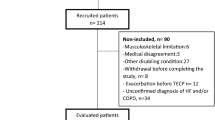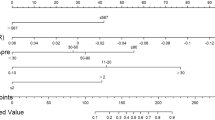Abstract
Objective: This study describes the prevalence and characteristics of an elevated resting energy expenditure (REE) in patients with chronic obstructive pulmonary disease (COPD).
Design and setting: Patients were consecutively admitted to an in-patient pulmonary rehabilitation centre.
Subjects: The study group consisted of 172 (123♂) clinically stable patients with COPD, age mean (s.d. ) 64 (10) y).
Interventions: REE was assessed by indirect calorimetry (ventilated hood) and adjusted for the influence of fat-free mass (FFM; measured by bioelectrical impedance analysis) using the linear regression equations of REE on FFM generated in 92 healthy age-matched subjects (58♂, age 67 (8) y) for men and women separately. The predicted REE adjusted for FFM (REEFFM) was obtained by using the FFM of each individual patient in the linear regression equation of REE on FFM generated in the healthy control group.
Results: 26% of the patients were hypermetabolic (defined as REE >110% REEFFM), characterized by a lower age (60 (10) vs 65 (9) y) and a lower total lung capacity (TLC; 122 (27) vs 139 (28)%pred) compared to normometabolic patients (P<0.001). The prevalence of FFM-depletion was equal among normo- and hypermetabolic patients: 36% vs 33% respectively. Depleted patients expressed however a significantly higher residual volume/TLC ratio and a lower maximal inspiratory mouth pressure independently of hyper-metabolism (P<0.05). In contrast, on base of the Harris & Benedict (HB) prediction equations, which do not take body composition into account, 54% of the patients were hypermetabolic (REE >110% REEHB), characterized by a higher age and a lower body mass and FFM (P<0.05).
Conclusions: Hypermetabolism commonly occurs in COPD, characterized by less hyperinflation at rest, in contrast to the suggested contribution of an elevated oxygen cost of breathing (OCB) to hypermetabolism in COPD. The higher hyperinflation at rest in FFM-depleted patients independently of hypermetabolism suggests a higher OCB during activities, contributing to the elevated total daily energy expenditure previously reported in COPD. The HB-equations overestimate the prevalence of hypermetabolism and link hypermetabolism incorrectly to aging and depletion.
This is a preview of subscription content, access via your institution
Access options
Subscribe to this journal
Receive 12 print issues and online access
$259.00 per year
only $21.58 per issue
Buy this article
- Purchase on Springer Link
- Instant access to full article PDF
Prices may be subject to local taxes which are calculated during checkout
Similar content being viewed by others
Author information
Authors and Affiliations
Rights and permissions
About this article
Cite this article
Creutzberg, E., Schols, A., Bothmer-Quaedvlieg, F. et al. Prevalence of an elevated resting energy expenditure in patients with chronic obstructive pulmonary disease in relation to body composition and lung function. Eur J Clin Nutr 52, 396–401 (1998). https://doi.org/10.1038/sj.ejcn.1600571
Received:
Revised:
Accepted:
Published:
Issue Date:
DOI: https://doi.org/10.1038/sj.ejcn.1600571
Keywords
This article is cited by
-
Quality of dietary intake in relation to body composition in patients with chronic obstructive pulmonary disease eligible for pulmonary rehabilitation
European Journal of Clinical Nutrition (2014)
-
Exercise intolerance and systemic manifestations of pulmonary emphysema in a mouse model
Respiratory Research (2009)
-
Nutritional depletion and its relationship to respiratory impairment in patients with chronic respiratory failure due to COPD or restrictive thoracic diseases
European Journal of Clinical Nutrition (2008)
-
Total daily energy expenditure in wasted chronic obstructive pulmonary disease patients
European Journal of Clinical Nutrition (2002)



